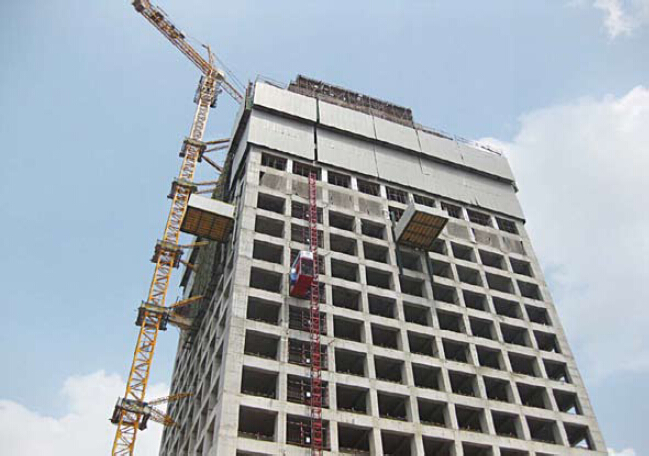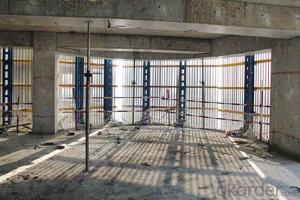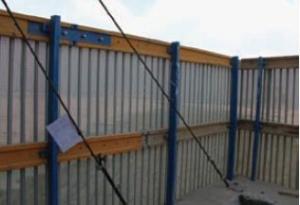Protection Platform for Formwork and Scaffolding Systems
- Loading Port:
- Tianjin
- Payment Terms:
- TT OR LC
- Min Order Qty:
- 50 m²
- Supply Capability:
- 1000 m²/month
OKorder Service Pledge
OKorder Financial Service
You Might Also Like
Protection Platform PP-50
A kind of new type construction protection system, applying operating platform and safer job
location for construction corps.
Characteristics:
◆ Easy and quick assembling.
◆ Lifted as a group, it is rapid and economic.
◆ Auto-climbing
◆ A safe and reliable anchor system
1. Composition
2. Assembly process of anchor system
(1) Embed V-climbing cone and anchor plate into the slab.
(2) Fix anchor shoe on the slab by tensile bolt.
(3) The fixed anchor shoe.
◆ High work efficiency with work platform and unload platform
◆ High light transmittance with the hollow block


- Q:Can steel formwork be custom-made?
- Indeed, the option of customizing steel formwork exists. Steel, being an adaptable material, can be effortlessly molded and joined together through welding to produce formwork tailored to suit specific project demands. In situations where conventional formwork systems may prove inadequate due to distinctive design components or intricate geometries, the utilization of custom-made steel formwork is frequently favored in construction endeavors. The customization of steel formwork allows construction firms to ensure a perfect fit, thereby facilitating efficient and precise pouring of concrete, minimizing waste, and preserving time and financial resources. Moreover, the durability and reusability of custom-made steel formwork offer enduring advantages for numerous construction projects in the long run.
- Q:What are the considerations when selecting the thickness of steel formwork?
- When selecting the thickness of steel formwork, there are several considerations to keep in mind. Firstly, the load-bearing capacity required for the formwork needs to be determined, taking into account factors such as the weight of the concrete, the expected live loads, and any additional loads that may be applied during construction. The desired lifespan of the formwork is another crucial factor, as thicker steel sheets tend to have a longer service life. The complexity and shape of the structure being formed should also be considered, as more intricate designs may require thicker steel to ensure stability and prevent deformation. Additionally, the cost implications of using thicker steel must be taken into account, balancing the benefits of increased strength and durability with the associated expenses. Overall, the selection of steel formwork thickness should be based on a thorough evaluation of these factors to ensure a safe and efficient construction process.
- Q:Can steel formwork be used in healthcare or medical facility construction projects?
- Yes, steel formwork can be used in healthcare or medical facility construction projects. Steel formwork offers durability, strength, and resistance to wear and tear, making it suitable for projects that require a high level of precision and structural integrity, such as healthcare or medical facilities. Additionally, steel formwork can be easily customized and assembled to meet the specific design requirements of these projects.
- Q:How does steel formwork handle different concrete early age strength development?
- Steel formwork is a versatile and durable material that is commonly used in construction for shaping and supporting concrete structures. When it comes to handling different concrete early age strength development, steel formwork demonstrates several advantages. Firstly, steel formwork provides excellent support and stability to the concrete during the initial stages of its curing process. This is crucial as the concrete gains strength and begins to harden. The rigid nature of steel formwork prevents any deformation or displacement, ensuring that the concrete retains its desired shape and structure as it sets. Additionally, steel formwork offers a high level of dimensional accuracy. This means that it can provide precise and consistent shapes and sizes to the concrete elements being constructed. This is particularly important during the early age strength development phase, as any variations or inconsistencies in the formwork could negatively impact the overall strength and integrity of the concrete. Furthermore, steel formwork is highly resistant to moisture and chemical reactions. Concrete undergoes a hydration process, where it absorbs water and undergoes chemical reactions to gain strength. Steel formwork, being non-absorbent, prevents excessive moisture from being absorbed by the concrete, which could lead to reduced strength development or even cracking. Additionally, steel formwork does not react chemically with the concrete, ensuring that the desired early age strength development is not compromised. Another advantage of steel formwork is its reusability. Unlike other formwork materials such as wood or plastic, steel formwork can be easily dismantled and reused for multiple construction projects. This not only reduces construction costs but also allows for consistent and reliable formwork performance, regardless of the concrete's early age strength development requirements. In conclusion, steel formwork is a reliable and efficient solution for handling different concrete early age strength development. Its stability, dimensional accuracy, resistance to moisture and chemical reactions, as well as its reusability, make it an ideal choice for shaping and supporting concrete structures during the crucial initial stages of curing.
- Q:I would like to ask you 60 models of building steel formwork, steel mold fixed method and fixed plate type fixed hole number
- Wood formwork is now commonly used in some special shaped concrete members, because it is easier to cut, production.
- Q:Does steel formwork require any special expertise or training for installation?
- Yes, steel formwork generally requires special expertise or training for installation. The process involves understanding the structural requirements, proper handling and assembling of steel components, as well as ensuring the formwork's stability and safety. Expertise in steel construction and knowledge of formwork systems are usually necessary for a successful installation.
- Q:What are the considerations when selecting the size and spacing of steel formwork panels?
- When selecting the size and spacing of steel formwork panels, several considerations need to be taken into account. First, the size of the panels should be determined based on the dimensions of the concrete structure being formed. The panels should be able to accommodate the desired shape and size of the concrete element. Secondly, the spacing between the panels should be chosen to ensure adequate support and stability. The spacing should be determined based on the load-bearing capacity of the panels and the weight of the concrete being poured. It is important to have proper spacing to prevent deflection or deformation of the formwork. Additionally, the size and spacing of the panels should also consider the ease of handling and installation. Panels that are too large or heavy may be difficult to transport and assemble, leading to time and labor inefficiencies. On the other hand, panels that are too small may result in excessive joints, increasing the chances of leakage or misalignment. Overall, the selection of the size and spacing of steel formwork panels should prioritize structural integrity, functionality, and ease of use to ensure successful and efficient concrete formwork construction.
- Q:Can steel formwork be used for both flat and sloped surfaces?
- Yes, steel formwork can be used for both flat and sloped surfaces. Steel formwork is highly versatile and can be easily adjusted or modified to suit different surface shapes and angles. It offers excellent strength and durability, making it suitable for various construction projects that involve both flat and sloped surfaces.
- Q:What is the difference between the steel template and the wood template? When to use steel formwork? When to use a wooden template?Now what kind of use
- Can use a combination of steel templates can also be used in large format steel formwork
- Q:Can steel formwork withstand extreme weather conditions?
- Yes, steel formwork is designed to withstand extreme weather conditions. Steel is known for its strength and durability, making it highly resistant to harsh weather elements such as heavy rain, strong winds, and high temperatures. Additionally, steel formwork is often treated with protective coatings to further enhance its resistance to corrosion and degradation caused by extreme weather conditions.
1. Manufacturer Overview |
|
|---|---|
| Location | |
| Year Established | |
| Annual Output Value | |
| Main Markets | |
| Company Certifications | |
2. Manufacturer Certificates |
|
|---|---|
| a) Certification Name | |
| Range | |
| Reference | |
| Validity Period | |
3. Manufacturer Capability |
|
|---|---|
| a)Trade Capacity | |
| Nearest Port | |
| Export Percentage | |
| No.of Employees in Trade Department | |
| Language Spoken: | |
| b)Factory Information | |
| Factory Size: | |
| No. of Production Lines | |
| Contract Manufacturing | |
| Product Price Range | |
Send your message to us
Protection Platform for Formwork and Scaffolding Systems
- Loading Port:
- Tianjin
- Payment Terms:
- TT OR LC
- Min Order Qty:
- 50 m²
- Supply Capability:
- 1000 m²/month
OKorder Service Pledge
OKorder Financial Service
Similar products
New products
Hot products
Hot Searches
Related keywords
























